Hot Tuna
Last updatedHot Tuna | |
|---|---|
 Casady, Kaukonen, and Mitterhoff performing in 2013 | |
| Background information | |
| Origin | San Francisco, California, U.S. |
| Genres | Blues rock, [1] Americana [2] |
| Years active | 1969–1977, 1983, 1986–present |
| Labels | RCA/Grunt, Relix, Eagle, Red House |
| Spinoff of | Jefferson Airplane |
| Members | Jack Casady Jorma Kaukonen |
| Past members | Will Scarlett Joey Covington Paul Kantner Marty Balin Peter Kaukonen Paul Ziegler Papa John Creach Sammy Piazza Bob Steeler Michael Falzarano Shigemi Komiyama Joey Balin Joey Stefko Harvey Sorgen Galen Underwood Pete Sears Erik Diaz Skoota Warner Barry Mitterhoff |
| Website | hottuna |
Hot Tuna is an American blues rock band formed in 1969 by former Jefferson Airplane members Jorma Kaukonen (guitarist/vocals) and Jack Casady (bassist). [3] Although it has always been a fluid aggregation, with musicians coming and going over the years, the band's center has always been Kaukonen and Casady's ongoing collaboration.
Contents
History
1969–1973: beginnings
Hot Tuna began as a side project to Jefferson Airplane, intended to mark time while Grace Slick recovered from vocal cord nodule surgery that had left her unable to perform. They initially named the group Hot Shit but then decided on the more innocuous Hot Tuna. [4] That name came from someone Jorma Kaukonen referred to as a "witty wag" who called out "hot tuna" after hearing the line "What's that smell like fish, oh baby", from the song "Keep On Truckin' ". [5] Kaukonen, Jack Casady, Paul Kantner and new drummer Joey Covington played several shows around San Francisco, including the Airplane's original club, The Matrix, before Jefferson Airplane resumed performing to support Volunteers . (Although Covington had been hired by Jefferson Airplane, he only performed at select engagements, with Spencer Dryden continuing to perform as the band's principal drummer until his 1970 dismissal). [6] Once the Airplane had resumed touring, Tuna found itself opening for the Airplane. Their early repertoire derived mainly from Kaukonen's Airplane material and covers of American country and blues artists such as Reverend Gary Davis, Jelly Roll Morton, Bo Carter and Blind Blake.
In September 1969, Kaukonen and Casady employed the moniker for a week of acoustic-based concerts at the New Orleans House in Berkeley, California; recordings culled from this engagement were released as the band's eponymous debut album in 1970. This album has become affectionately known by the group's fans as the "breaking glass album", because of the sound of breaking beer glasses during the recording of "Uncle Sam Blues". [7] Some tracks included Will Scarlett on harmonica. [8] [ third-party source needed ] After the album was recorded, Jorma's brother Peter Kaukonen soon replaced Kantner on rhythm guitar and Jefferson Airplane co-lead vocalist Marty Balin joined on vocals for the electric songs. In 1970, the younger Kaukonen was replaced by Paul Ziegler.

That summer, RCA paid for the band to go to Jamaica to record their next album, but the album was never finished, in part due to a financial dispute between Balin (who left both bands shortly thereafter) and Kaukonen and Casady. [6] Violinist Papa John Creach joined Hot Tuna and Jefferson Airplane in October 1970. Both bands finished a joint tour in November 1970 with shows at the Fillmore East.
In September 1970, Kaukonen and Casady performed two acoustic-based shows as Hot Tuna without Jefferson Airplane at Pepperland (a large dance hall in San Rafael, California) and received good reviews, [6] further signifying that Hot Tuna could survive without the other band to support it.
As Jefferson Airplane wound down and stopped regularly touring for over eighteen months (save for a handful of concerts in the summer of 1971 and winter of 1972) after the Fillmore East shows, Hot Tuna became an independent group. In this era, Hot Tuna's members were Kaukonen, Casady, drummer Sammy Piazza, and Creach, moving fully to the electric band format. This lineup was first documented on the album First Pull Up, Then Pull Down (1971), which was recorded live at the Chateau Liberte, an obscure club located near Los Gatos, California, in the Santa Cruz Mountains that was favored by the band throughout the era. The group also appeared on three tracks from Papa John Creach's debut solo album, as well as "Walking the Tou Tou" from his second album, Filthy!
The studio albums Burgers (1972) and The Phosphorescent Rat (1974) followed, with Creach leaving before the latter was recorded. These two albums featured mostly Kaukonen compositions. On the former album, David Crosby sang supporting vocals on "Highway Song", while keyboardist Nick Buck (who frequently guested with the group in the studio for the next five years before serving as a touring member in 1977) contributed to two tracks.
1974–1977: Power trio
As the band prepared for its 1974 tour in support of The Phosphorescent Rat, Kaukonen laid off Piazza after deciding to have the band return to its semi-acoustic repertoire. [6] Kaukonen and Casady then proceeded to record Kaukonen's first solo album, Quah . However, July 1974 marked a departure from their primarily bluesy, acoustic style when Hot Tuna dropped their acoustic sets completely and morphed into a heavy rock band. In October 1974, the group performed on The Midnight Special .
The albums America's Choice (1975), Yellow Fever (1975), and Hoppkorv (1976) showcase a power trio with the addition of new drummer Bob Steeler. Jeff Tamarkin's liner notes on the RCA "Platinum Gold Hot Tuna Collection" characterize this trilogy as being emblematic of the band's "rampage years." Kaukonen is quoted as saying the change of focus was due to the fact that "it was just fun to be loud." During this period, Kaukonen's electric guitar playing was multi-layered, prominently showcasing such effects as the Roland Jet phaser. His "rampage" style is typified by the solos on "Funky #7" and "Serpent of Dreams" on America's Choice and "Song for the Fire Maiden," "Sunrise Dance with the Devil," and "Surphase Tension" on Yellow Fever. Live performances throughout the epoch were distinguished by free-flow improvisational jams and very long sets (up to six hours uninterrupted) with extended versions of their studio material. A November 1976 concert at the Palladium in New York City featured a 16-minute version of "Invitation." However, producer Harry Maslin did not appreciate the group's style and held them to a more traditional rock format (including several cover songs) for Hoppkorv. In 1977, Kaukonen began to perform solo sets before the band would perform. The trio stopped touring at the end of 1977 and performed its final concert at the Palladium on November 26, with keyboardist Nick Buck and saxophonist "Buffalo" Bob Roberts.
Although live performances from all iterations of the group enjoyed a notable cult following for much of the 1970s, Hot Tuna failed to rival or eclipse Jefferson Airplane and Jefferson Starship from a commercial standpoint. All but two Hot Tuna albums from the era reached the Billboard Top 100, America's Choice was their only post-1972 album to chart for more than ten weeks, peaking at No. 75. [9]
1978–1985: hiatus and brief reunion
Due to emergent tensions between Kaukonen and Casady, a planned 1978 tour was canceled, with Kaukonen filling these dates by performing solo. A double live album, Double Dose , was released that year as a document of the previous year's tour. Casady and Kaukonen went their separate ways and pursued short-lived careers in the new wave bands SVT and Vital Parts, respectively. In 1979, Kaukonen released his second solo album and Grunt Records released the Hot Tuna compilation Final Vinyl .
Rhythm guitarist Michael Falzarano and drummer Shigemi Komiyama joined Kaukonen and Casady for a Hot Tuna reunion tour in 1983. The group played a mix of new material alongside the classic Hot Tuna songs. [10] This, combined with the group's hard rock and heavy metal approach, were not well received, with reports of fans walking out of shows. [6] [11]
1986–present

Hot Tuna again reformed in 1986, with producer Joey Balin joining on rhythm guitar until 1987. Kantner joined the band in 1987 and 1988, adding some old Jefferson Airplane songs to the setlist. Grace Slick appeared with them for one show at The Fillmore in March 1988. The band continued into 1989 and Kaukonen and Casady joined the 1989 Jefferson Airplane reunion album and tour, performing acoustic Hot Tuna sets in the middle of each show. At the end of the Airplane tour, Hot Tuna resumed their electric performances, adding Falzarano and drummer Joey Stefko. Shortly thereafter, New Yorker Harvey Sorgen replaced Stefko on drums and Galen Underwood joined on keyboards for their first album of all new material in almost 14 years, 1990's Pair a Dice Found . Kaukonen and Falzarano both contributed original songs.
Throughout the 1990s, Hot Tuna again alternated between acoustic and electric styles. The two Sweetwater albums were predominantly acoustic sets with guests such as Bob Weir, Maria Muldaur and former Jefferson Starship bassist-keyboardist Pete Sears; the latter was to join the group for the remainder of the decade.
On August 13th, 1994 the duo would perform with "The Band & Friends" (along with Bruce Hornsby) on the South Stage at Woodstock '94.
The 1997 release Live in Japan was in many ways reminiscent of the very first Hot Tuna album, having a minimalistic sound and being recorded live at a tiny venue (Stove's in Yokohama). [12] Falzarano and Sears stayed with the band until the early 2000s. [13]
In 2004, Casady and Kaukonen were joined by mandolinist Barry Mitterhoff and drummer Erik Diaz. In August 2009, following the departure of Diaz, Skoota Warner officially joined the band as drummer. In November 2010, Hot Tuna performed as a semi-acoustic trio: Casady, Kaukonen and Mitterhoff at a Midnight Ramble at Levon Helm's Barn studio in Woodstock, New York. In the same month, Kaukonen announced on his blog that Hot Tuna had begun recording its first studio album in 20 years. [14] The album, Steady as She Goes , was released by Red House Records on April 5, 2011. [15] For the first half of 2011, guitarist Jim Lauderdale and harmonica player Charlie Musselwhite toured with them; later in the year they were joined by Musselwhite, guitarists David Bromberg, Larry Campbell, Steve Kimock, and G. E. Smith, and vocalist Teresa Williams. [16] Both Campbell and Williams, who guested on the Steady as She Goes album, have remained with the band in a touring capacity. In 2014, Justin Guip, who had engineered the album in addition to Kaukonen's recent solo work, took over drumming duties from Warner. [17]
Personnel
Members
The band has performed live as Hot Tuna between 1969 and 1977; in 1983; and from 1986 to present: [6] [18]
Current members
- Jack Casady – bass (1969–1977, 1983, 1986–present)
- Jorma Kaukonen – lead guitar, vocals (1969–1977, 1983, 1986–present)
- Touring musicians
- Larry Campbell – rhythm guitar, vocals, violin, lap steel guitar (2011–present)
- Teresa Williams – vocals (2011–present)
- Justin Guip – drums (2014–present)
- Studio musicians
- Robert McCrimlisk – mandolin (2014–present)
- Christopher McGrath – banjo (2014–present)
Former members
|
|
- Studio and touring musicians
- Will Scarlett – harmonica (1969–1971)
- Nick Buck – keyboards (1976–1978)
- Jim Lauderdale – rhythm guitar (2011)
- Charlie Musselwhite – harmonica (2011)
- David Bromberg – rhythm guitar (2011)
- Steve Kimock – rhythm guitar (2011)
- G. E. Smith – rhythm guitar (2011)
Timeline

Lineups
| 1969 | 1969–1970 | 1970 | 1970 |
|---|---|---|---|
|
|
|
|
| 1970–1973 | 1973 | 1973–1974 | 1974–1977 |
|
|
|
|
| 1977–1983 | 1983 | 1983–1986 | 1986–1987 |
Disbanded |
| Disbanded |
|
| 1987–1988 | 1988–1989 | 1989–1990 | 1990 |
|
|
|
|
| 1990–1992 | 1992–2000 | 2000–2001 | 2001–2002 |
|
|
|
|
| 2002–2004 | 2004–2009 | 2009–2014 | 2014–present |
|
|
|
|
Discography
- Hot Tuna (1970)
- First Pull Up, Then Pull Down (1971)
- Burgers (1972)
- The Phosphorescent Rat (1974)
- America's Choice (1975)
- Yellow Fever (1975)
- Hoppkorv (1976)
- Double Dose (1978)
- Pair a Dice Found (1990)
- Live at Sweetwater (1992)
- Live at Sweetwater Two (1993)
- Live in Japan (1997)
- And Furthurmore... (1999)
- Steady as She Goes (2011)
Related Research Articles

Jefferson Airplane was an American rock band based in San Francisco, California, that became one of the pioneering bands of psychedelic rock. Formed in 1965, the group defined the San Francisco Sound and was the first from the Bay Area to achieve international commercial success. They headlined the Monterey Pop Festival (1967), Woodstock (1969), Altamont Free Concert (1969), and the first Isle of Wight Festival (1968) in England. Their 1967 breakout album Surrealistic Pillow was one of the most significant recordings of the Summer of Love. Two songs from that album, "Somebody to Love" and "White Rabbit", are among Rolling Stone's "500 Greatest Songs of All Time".

Jefferson Starship is an American rock band from San Francisco, California, formed in 1974 by a group of musicians including former members of Jefferson Airplane. Between 1974 and 1984, they released eight gold or platinum-selling studio albums, and one gold-selling compilation. The album Red Octopus went double-platinum, reaching No. 1 on the Billboard 200 chart in 1975. The band went through several major changes in personnel and genres through the years while retaining the Jefferson Starship name. The band name was retired in 1984, but it was picked up again in 1992 by a revival of the group led by Paul Kantner, which has continued since his death in 2016.
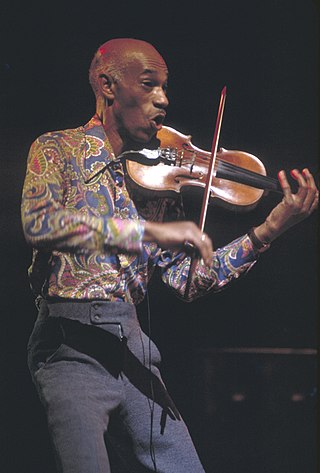
John Henry Creach, better known as Papa John Creach, was an American blues violinist who also played classical, jazz, R&B, pop and acid rock music. Early in his career, he performed as a journeyman musician with Louis Armstrong, Fats Waller, Stuff Smith, Charlie Christian, Big Joe Turner, T-Bone Walker, Nat King Cole and Roy Milton.

Jorma Ludwik Kaukonen, Jr. is an American blues, folk, and rock guitarist. Kaukonen performed with Jefferson Airplane and still performs regularly on tour with Hot Tuna, which started as a side project with bassist Jack Casady, and as of early 2019 has continued for 50 years. Rolling Stone magazine ranked him No. 54 on its list of 100 Greatest Guitarists. He was inducted into the Rock and Roll Hall of Fame in 1996 as a member of Jefferson Airplane.

John William Casady is an American bass guitarist, best known as a member of Jefferson Airplane and Hot Tuna. Jefferson Airplane became the first successful exponent of the San Francisco Sound. Singles including "Somebody to Love" and "White Rabbit" charted in 1967 and 1968. Casady, along with the other members of Jefferson Airplane, was inducted into the Rock and Roll Hall of Fame in 1996.

Bark is the sixth studio album by American rock band Jefferson Airplane. Released in 1971 as Grunt FTR-1001, the album is one of the Airplane's late-period works, notable for the group's first personnel changes since 1966. The album was the first without band founder Marty Balin and the first with violinist Papa John Creach. Drummer Spencer Dryden had been replaced by Joey Covington in early 1970 after a lengthy transitional period in which both musicians had performed with the band.
Long John Silver is the seventh studio album by the American rock band Jefferson Airplane, and their last album of all new material until 1989. It was recorded and released in 1972 as Grunt FTR-1007.

Jefferson Airplane is the eighth and final studio album by San Francisco rock band Jefferson Airplane, released on Epic Records in 1989. Marty Balin, Paul Kantner, Grace Slick, Jorma Kaukonen and Jack Casady all returned for the album and supporting tour, though Spencer Dryden did not participate. The album and accompanying tour would mark the last time Jefferson Airplane would perform together until their 1996 induction to the Rock and Roll Hall of Fame.

Flight Log (1966–1976) is a compilation album by the American rock band Jefferson Airplane. Released in January 1977 as a double-LP as Grunt CYL2-1255, it is a compilation of Jefferson Airplane and Airplane-related tracks, including tracks by Jefferson Starship and Hot Tuna, as well as solo tracks by Paul Kantner, Grace Slick, and Jorma Kaukonen. Although primarily a compilation album, the album includes one previously unreleased song: "Please Come Back" written by Ron Nagle and performed by Jefferson Starship. "Please Come Back" is not available on any other release.

Hot Tuna is the debut album by the American blues rock band Hot Tuna, released in 1970 as RCA Victor LSP-4353. It was recorded live at the New Orleans House in Berkeley, California in September 1969. It peaked at #30 on the Billboard 200 album chart.
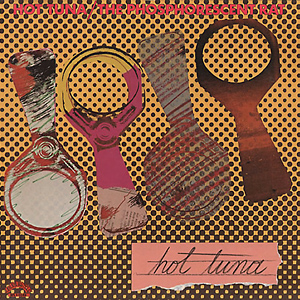
The Phosphorescent Rat is the fourth album by the blues rock group Hot Tuna, released in early 1974 as Grunt BFL1-0348. This was the first Hot Tuna album recorded after guitarist Jorma Kaukonen and bass player Jack Casady had left Jefferson Airplane. They were joined as before by drummer Sammy Piazza, though Papa John Creach had left the band for Jefferson Starship. The band's playing was moving away from the softer, more acoustic sound of their first three albums, and towards a hard rock sound that would be explored on their next three albums.
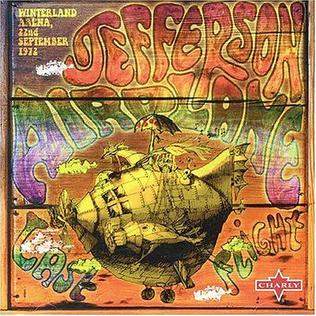
Last Flight is an authorized recording released in the United Kingdom, taken from the last live performance of the San Francisco rock group Jefferson Airplane prior to the band's dissolution in 1972. The concert was held at the Winterland Arena in San Francisco, and selected tracks were released on the 1973 album Thirty Seconds Over Winterland. Last Flight consists of the entire concert with the exception of the encore, Marty Balin's "You Wear Your Dresses Too Short", previously released on the Jefferson Airplane Loves You box-set. Balin sings lead vocals on "Volunteers" much to the surprise of the audience since he left the band in late 1970.

Grunt Records was a vanity label founded in 1971 by Jefferson Airplane and distributed by RCA Records. Initially created to sign local Bay Area acts, the label later was used only for Jefferson Starship and Hot Tuna releases. The label ended use in 1987 after Grace Slick left Starship.

Pair a Dice Found is an album by the American blues rock band Hot Tuna. Released in 1990, it was their first studio album since Hoppkorv in 1976.

Historic Live Tuna is an album by the band Hot Tuna. It was released in 1985. Side A contains previously unreleased tracks from a live acoustic performance played on KSAN radio in 1971. Side B contains previously unreleased material from a live electric performance in 1971 recorded at the Fillmore West auditorium in San Francisco. The album was Hot Tuna's second release on Relix Records, and would be their last release until after the 1989 Jefferson Airplane reunion tour and reunion album, when they were signed to Epic Records for a short time before returning to Relix.
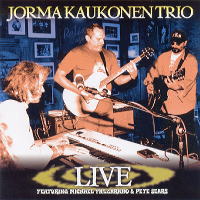
Jorma Kaukonen Trio Live is a live album taken from performances from Jorma Kaukonen's 1999 solo tour, and his last album for Relix Records. Performing with Kaukonen were Michael Falzarano and Pete Sears who had both played on his previous solo album, Too Many Years, and had performed with Hot Tuna on their last release, And Furthermore... After the release of this album, Kaukonen and Jack Casady began to perform as "Jack & Jorma, The Original Acoustic Hot Tuna" and Falzarano and Sears performed less frequently with Hot Tuna and Kaukonen's solo act, with Sears finally leaving in 2001 and Falzarano leaving in 2002.
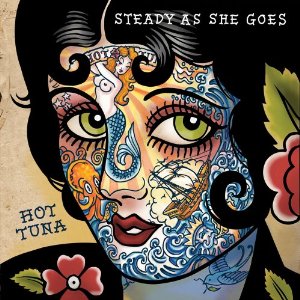
Steady as She Goes is a 2011 album by Hot Tuna, the band's first studio album since 1990. After Jorma Kaukonen recorded his solo album in 2009 at Levon Helm's studio in NY, he asked his new record company Red House if they would be interested in a Tuna album. The band started recording new tracks in November 2010 with the same producer and studio that Kaukonen used for River of Time and features the latest lineup of the band that formed in 2009 when Skoota Warner joined on drums. On March 11, 2011, Red House released "Angel of Darkness" as a free single. The album was released on CD and on iTunes April 5, 2011 and was released on vinyl in May. The album first charted on the Tastemaker and Independent album lists compiled by Billboard for the week of April 23.
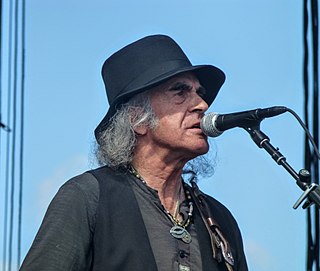
Peter Roy Sears is an English rock music musician. In a career spanning more than six decades, he has been a member of many bands and has moved through a variety of musical genres, from early R&B, psychedelic improvisational rock of the 1960s, folk, country music, arena rock in the 1970s, and blues. He usually plays bass, keyboards, or both in bands.
References
- ↑ Prown, Pete; Newquist, Harvey P. (1997). Legends of Rock Guitar: The Essential Reference of Rock's Greatest Guitarists (4th ed.). Hal Leonard Corporation. p. 55. ISBN 0-7935-4042-9.
- ↑ Boyle, David (June 15, 2019). "Hot Tuna Playing at the Egyptian Theatre This Weekend". KPCW . Retrieved February 18, 2021.
- ↑ Ankeny, Jason. "Hot Tuna on Allmusic". Allmusic.com. Retrieved November 5, 2011.
- ↑ "Jefferson Airplane's Jorma Kaukonen". MTV. Retrieved May 8, 2024.
- ↑ Wilson, Dave (2004). Rock formations: Categorical answers to how band names were formed. Cidermill Books. p. 83. ISBN 978-0-9748483-5-8.
Jorma Kaukonen has been quoted as saying that the name is an answer to a question posed in their song 'Keep on Truckin'', as adapted from Blind Boy Fuller's 1938 song 'What's That Smell Like Fish?'
- 1 2 3 4 5 6 Tamarakin, Jeff (2003). Got a Revolution: The Turbulent Flight of Jefferson Airplane. Simon and Schuster. ISBN 0-671-03403-0.
- ↑ Hot Tuna (Remaster CD booklet). Hot Tuna. New York City: RCA. 1970. LSP-3864.
{{cite AV media notes}}: CS1 maint: others in cite AV media (notes) (link) - ↑ "About" Archived May 10, 2017, at the Wayback Machine Will Scarlett website
- ↑ "Hot Tuna – Chart history | Billboard". Billboard . Archived from the original on August 27, 2017. Retrieved June 24, 2017.
- ↑ Kaukonen, Jorma. "Jorma Kaukonen 1984: In Conversation with Tony Traguardo & George Walsh". traguardo.com (Interview). Interviewed by Tony Traguardo. Archived from the original on February 2, 2017. Retrieved January 24, 2017.
- ↑ Casady, Jack (March 1987). "Casady Promises Fresh Approach". Syracuse Herald Journal (Interview). Interviewed by Brian G. Bourke.
- ↑ Bendersky, Ari. "Hot Tuna in the Raw", Rolling Stone, April 24, 1998 [ dead link ]
- ↑ John Metzger (December 5, 1997). "Metzger, John. "Hot Tuna Blues", The Music Box, February 1998". Musicbox-online.com. Archived from the original on October 25, 2011. Retrieved November 5, 2011.
- ↑ "Cracks in the Finish". Jormakaukonen.com. Archived from the original on July 13, 2011. Retrieved July 5, 2011.
- ↑ "Red House Records 1-800-695-4687". Redhouserecords.com. Archived from the original on December 4, 2011. Retrieved July 5, 2011.
- ↑ "Electric Hot Tuna 2011 Beacon Show NYC! - Hot Tuna". Archived from the original on September 21, 2016. Retrieved February 22, 2016.
- ↑ "Thank You Tuna Nation! - Hot Tuna". Archived from the original on September 20, 2016. Retrieved February 22, 2016.
- ↑ "TunaBase". TunaBase. Archived from the original on July 17, 2011. Retrieved July 5, 2011.
External links
Text is available under the CC BY-SA 4.0 license; additional terms may apply.
Images, videos and audio are available under their respective licenses.